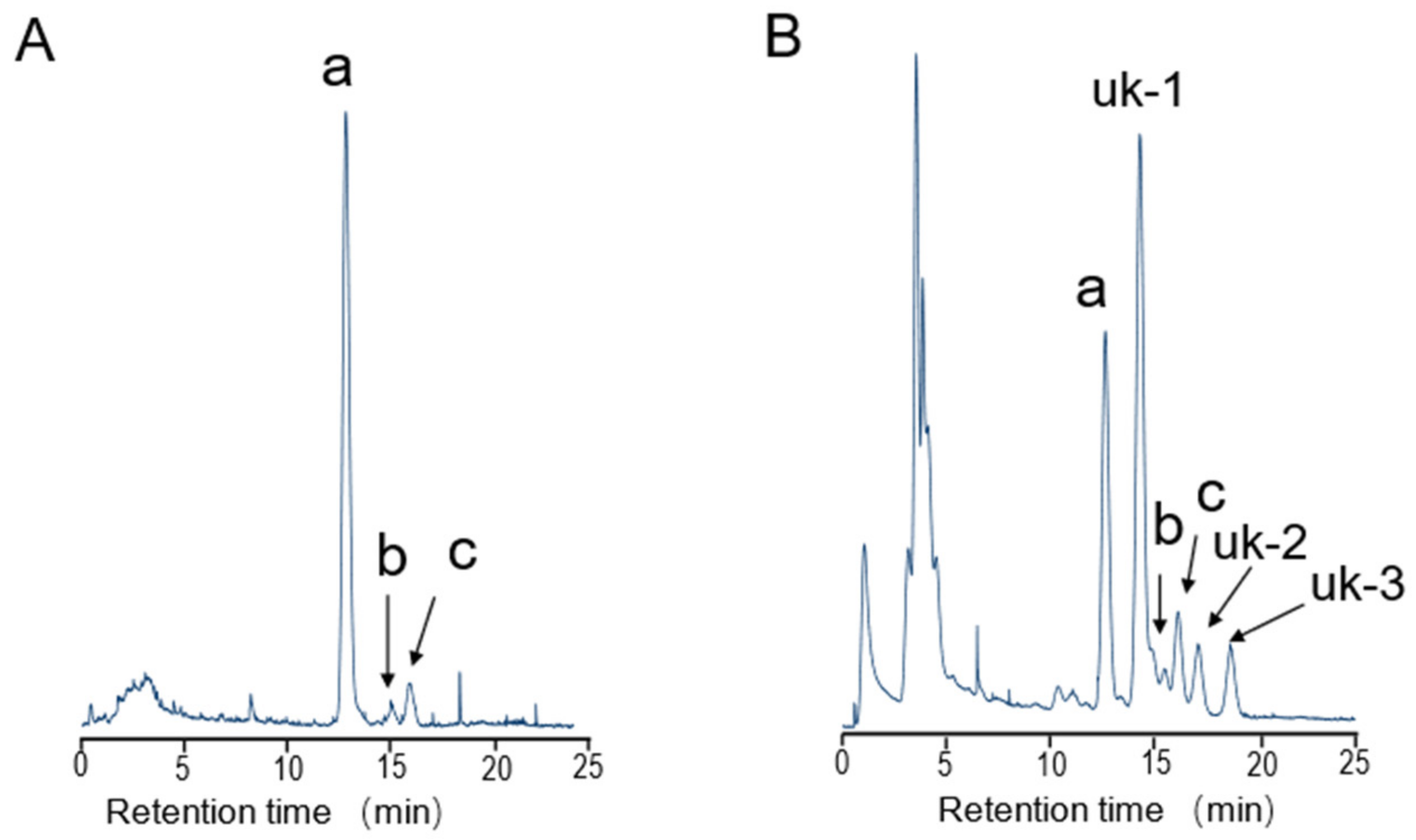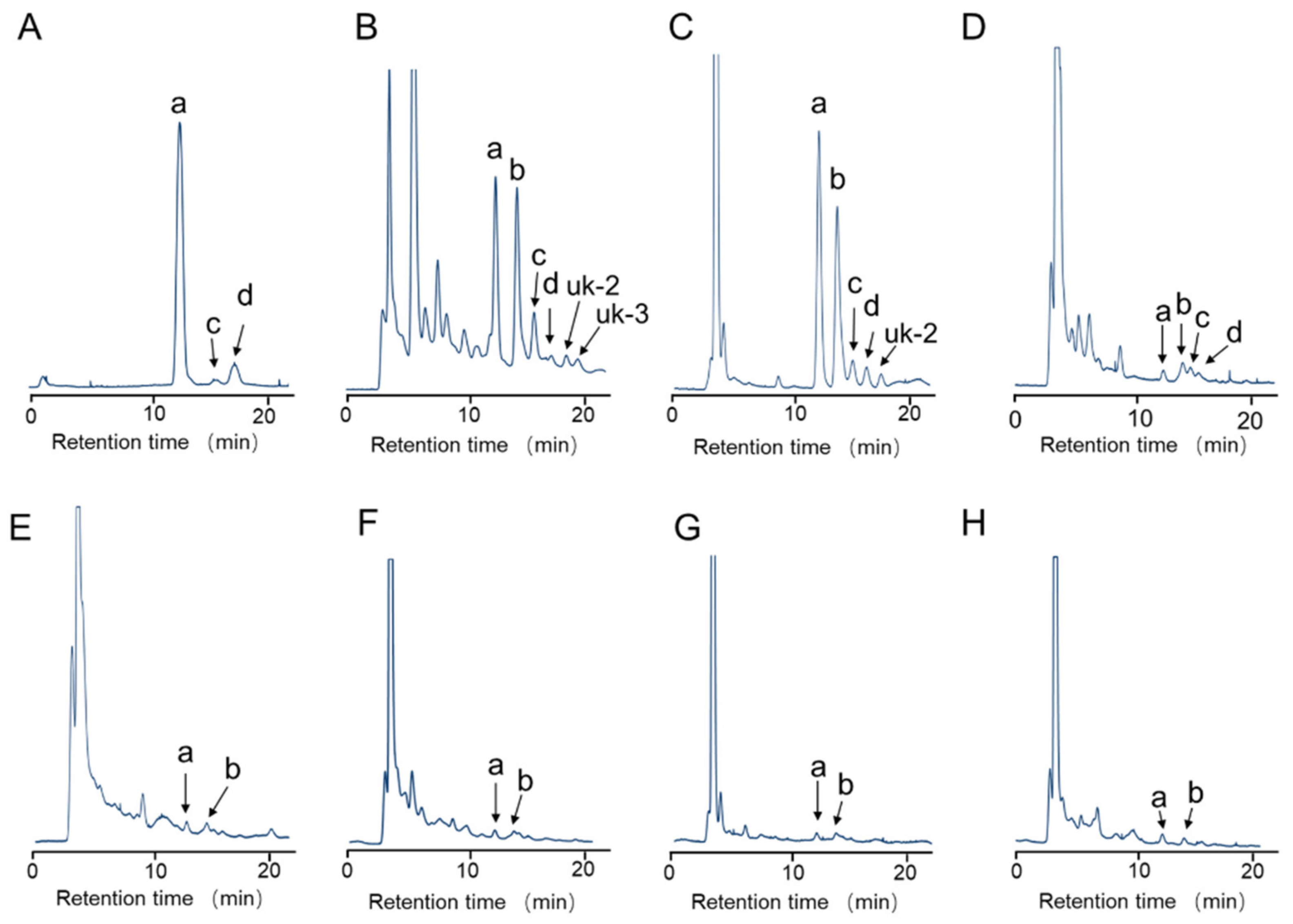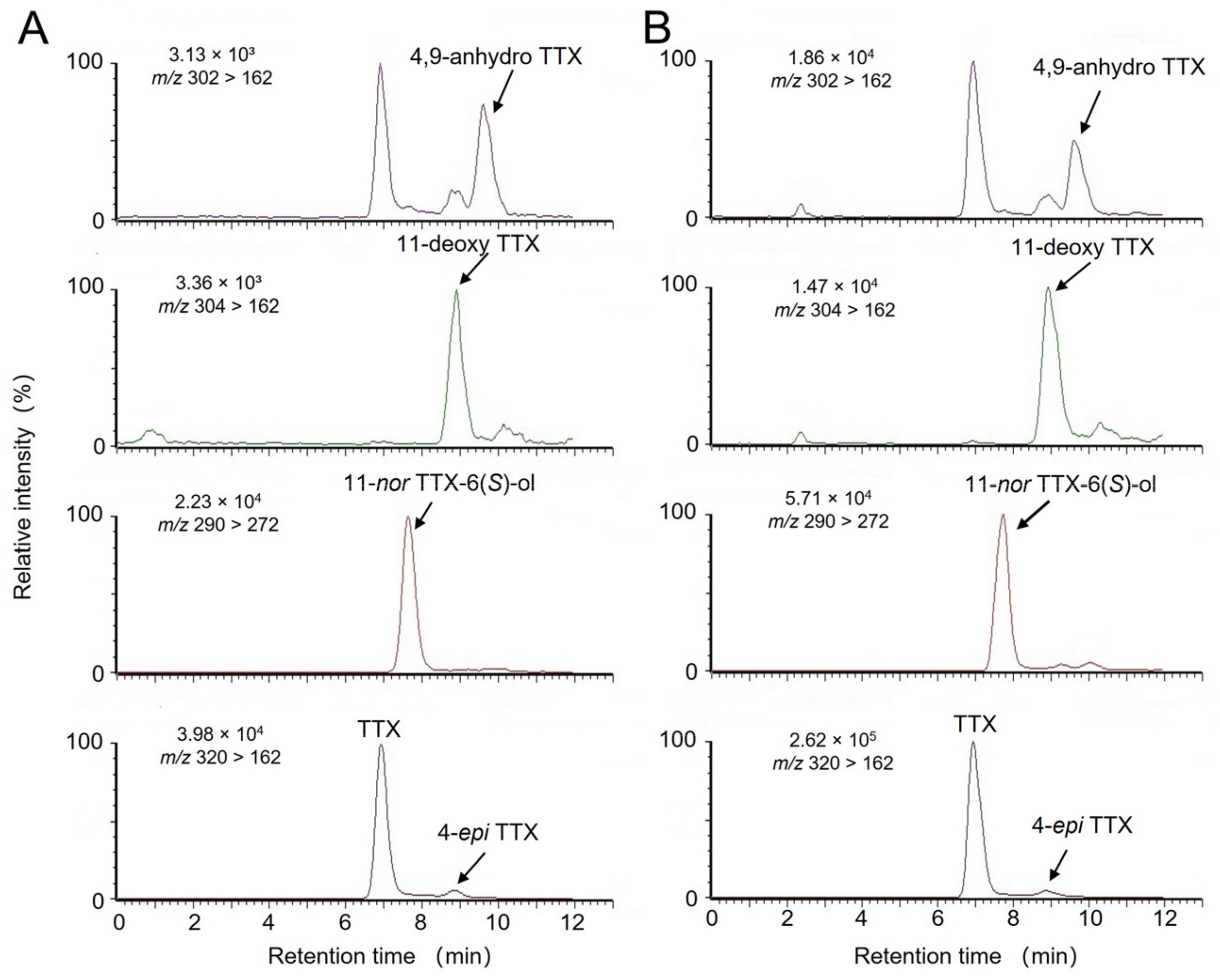Tetrodotoxin Profiles in Xanthid Crab Atergatis floridus and Blue-Lined Octopus Hapalochlaena cf. fasciata from the Same Site in Nagasaki, Japan
Abstract
1. Introduction
2. Results
2.1. Toxin Concentrations of A. floridus in 2020
2.2. Toxin Concentrations and Profiles of A. floridus and Blue-Lined Octopus H. cf. fasciata in 2021
3. Discussion
4. Materials and Methods
4.1. Sample Collection
4.2. Toxin Extraction from A. floridus
4.3. Toxin Extraction from H. cf. fasciata
4.4. Mouse Bioassay
4.5. Purification of TTX and TTX Analogs
4.6. Toxin Analysis by Instruments
4.6.1. Liquid Chromatography-Tandem Mass Spectrometry for TTXs
4.6.2. High-Performance Liquid Chromatography with Fluorometric Detection for TTXs
4.6.3. High-Performance Liquid Chromatography with Fluorometric Detection for PSTs
Supplementary Materials
Author Contributions
Funding
Institutional Review Board Statement
Informed Consent Statement
Data Availability Statement
Acknowledgments
Conflicts of Interest
References
- Narahashi, T. Pharmacology of tetrodotoxin. J. Toxicol. Toxin Rev. 2001, 20, 67–84. [Google Scholar] [CrossRef]
- Hwang, D.F.; Noguchi, T. Tetrodotoxin Poisoning. In Advances in Food and Nutrition Research; Academic Press: Cambridge, MA, USA, 2007; Volume 52, pp. 141–236. [Google Scholar]
- Sheumack, D.; Howden, M.; Spence, I.; Quinn, R.J.S. Maculotoxin: A neurotoxin from the venom glands of the octopus Hapalochlaena maculosa identified as tetrodotoxin. Science 1978, 199, 188–189. [Google Scholar] [CrossRef] [PubMed]
- Mosher, H.; Fuhrman, F.; Buchwald, H.; Fischer, H.J.S. Tarichatoxin—Tetrodotoxin: A Potent Neurotoxin: A nonprotein substance isolated from the California newt is the same as the toxin from the puffer fish. Science 1964, 144, 1100–1110. [Google Scholar] [CrossRef]
- Kim, Y.H.; Brown, G.B.; Mosher, H.S.; Fuhrman, F.A. Tetrodotoxin: Occurrence in atelopid frogs of Costa Rica. Science 1975, 189, 151–152. [Google Scholar] [CrossRef]
- Konosu, S.; Inoue, A.; Noguchi, T.; Hashimoto, Y. A further examination on the toxicity of three species of xanthid crab. Bull. Jap. Soc. Sci. Fish. 1969, 35, 88–92. [Google Scholar] [CrossRef]
- Melnikova, D.I.; Magarlamov, T.Y. An Overview of the Anatomical Distribution of Tetrodotoxin in Animals. Toxins 2022, 14, 576. [Google Scholar] [CrossRef]
- Miyazawa, K.; Jeon, J.K.; Maruyama, J.; Noguchi, T.; Ito, K.; Hashimoto, K. Occurrence of tetrodotoxin in the flatworm Planocera multitentaculata. Toxicon 1986, 24, 645–650. [Google Scholar] [CrossRef] [PubMed]
- Magarlamov, T.Y.; Melnikova, D.I.; Chernyshev, A.V. Tetrodotoxin-Producing Bacteria: Detection, Distribution and Migration of the Toxin in Aquatic Systems. Toxins 2017, 9, 166. [Google Scholar] [CrossRef] [PubMed]
- Yasumoto, T.; Nagai, H.; Yasumura, D.; Michishita, T.; Endo, A.; Yotsu, M.; Kotaki, Y. Interspecies distribution and possible origin of tetrodotoxin. Ann. N. Y. Acad. Sci. 1986, 479, 44–51. [Google Scholar] [CrossRef]
- Katikou, P.; Gokbulut, C.; Kosker, A.R.; Campàs, M.; Ozogul, F. An Updated Review of Tetrodotoxin and Its Peculiarities. Mar. Drugs 2022, 20, 47. [Google Scholar] [CrossRef]
- Puilingi, C.G.; Kudo, Y.; Cho, Y.; Konoki, K.; Yotsu-Yamashita, M. Tetrodotoxin and Its Analogues in the Pufferfish Arothron hispidus and A. nigropunctatus from the Solomon Islands: A Comparison of Their Toxin Profiles with the Same Species from Okinawa, Japan. Toxins 2015, 7, 3436–3454. [Google Scholar] [CrossRef] [PubMed]
- Bane, V.; Lehane, M.; Dikshit, M.; O’Riordan, A.; Furey, A. Tetrodotoxin: Chemistry, Toxicity, Source, Distribution and Detection. Toxins 2014, 6, 693–755. [Google Scholar] [CrossRef] [PubMed]
- Yotsu-Yamashita, M.; Sugimoto, A.; Takai, A.; Yasumoto, T. Effects of Specific Modifications of Several Hydroxyls of Tetrodotoxin on Its Affinity to Rat Brain Membrane. J. Pharmacol. Exp. Ther. 1999, 289, 1688. [Google Scholar] [PubMed]
- Williams, B.L.; Caldwell, R.L. Intra-organismal distribution of tetrodotoxin in two species of blue-ringed octopuses (Hapalochlaena fasciata and H. lunulata). Toxicon 2009, 54, 345–353. [Google Scholar] [CrossRef] [PubMed]
- Kim, H.S.; Kwun, H.J.; Bae, H.; Park, J. First reliable record of the blue-lined octopus, Hapalochlaena fasciata (Hoyle, 1886) (Cephalopoda: Octopodidae), from Jeju Island, Korea. J. Asia-Pac. Biodivers. 2018, 11, 21–24. [Google Scholar] [CrossRef]
- Yamate, Y.; Takatani, T.; Takegaki, T. Levels and distribution of tetrodotoxin in the blue-lined octopus Hapalochlaena fasciata in Japan, with special reference to within-body allocation. J. Molluscan Stud. 2021, 87, eyaa042. [Google Scholar] [CrossRef]
- Yamate, Y.; Toyomasu, N.; Takegaki, T. Distribution, body size and maturation pattern of the blue-lined octopus Hapalochlaena cf fasciata in Japan. Nippon Suisan Gakkaishi 2022, 88, 171–173. [Google Scholar] [CrossRef]
- Yotsu-Yamashita, M.; Mebs, D.; Flachsenberger, W. Distribution of tetrodotoxin in the body of the blue-ringed octopus (Hapalochlaena maculosa). Toxicon 2007, 49, 410–412. [Google Scholar] [CrossRef]
- Asakawa, M.; Matsumoto, T.; Umezaki, K.; Kaneko, K.; Yu, X.; Gomez-Delan, G.; Tomano, S.; Noguchi, T.; Ohtsuka, S. Toxicity and Toxin Composition of the Greater Blue-Ringed Octopus Hapalochlaena lunulata from Ishigaki Island, Okinawa Prefecture, Japan. Toxins 2019, 11, 245. [Google Scholar] [CrossRef] [PubMed]
- Hashimoto, Y.; KoNosu, S.; Inoue, A.; Saisho, T.; Miyake, S. Screening of toxic crabs in the Ryukyu and Amami Islands. Bull. Jap. Soc. Sci. Fish. 1969, 35, 83–87. [Google Scholar] [CrossRef]
- Tsai, Y.-H.; Hwang, D.-F.; Chai, T.-J.; Jeng, S.-S. Toxicity and toxic components of two xanthid crabs, Atergatis floridus and Demania reynaudi, in Taiwan. Toxicon 1997, 35, 1327–1335. [Google Scholar] [CrossRef]
- Noguchi, T.; Arakawa, O.; Daigo, K.; Oikawa, H.; Asakawa, M.; Miyazawa, K. Chapter 36—Different intoxication mechanism between paralytic shellfish toxin (PST)-and/or tetrodotoxin-contaminated xanthid crabs and PST-contaminated edible shore crabs in Japan and their food poisonings. In Handbook of Algal Science, Technology and Medicine; Konur, O., Ed.; Academic Press: Cambridge, MA, USA, 2020; pp. 575–589. [Google Scholar]
- Koyama, K.; Noguchi, T.; Uzu, A.; Hashimoto, K. Individual, local, and size-dependent variations in toxicity of the xanthid crab Zosimus aeneus. Bull. Jap. Soc. Sci. Fish. 1983, 49, 1273–1279. [Google Scholar] [CrossRef]
- Asakawa, M.; Tsuruda, S.; Ishimoto, Y.; Shimomura, M.; Kishimoto, K.; Shida, Y.; Barte-Quilantang, M.; Gomez-Delan, G. Paralytic toxin profiles of xanthid crab Atergatis floridus collected on reefs of Ishigaki Island, Okinawa Prefecture, Japan and Camotes Island, Cebu Province, Philippines. Sci. J. Clin. Med. 2014, 3, 75–81. [Google Scholar] [CrossRef]
- Zhang, Y.; Tsutsui, H.; Yamawaki, N.; Morii, Y.; Nishihara, G.N.; Itoi, S.; Arakawa, O.; Takatani, T. Geographic Variations in the Toxin Profile of the Xanthid Crab Zosimus aeneus in a Single Reef on Ishigaki Island, Okinawa, Japan. Mar. Drugs 2021, 19, 670. [Google Scholar] [CrossRef]
- Kotaki, Y.; Tajiri, M.; Oshima, Y.; Yasumoto, T. Identification of a calcareous red alga as the primary source of paralytic shellfish toxins in coral reef crabs and gastropods. Bull. Jap. Soc. Sci. Fish. 1983, 49, 283–286. [Google Scholar] [CrossRef]
- Ambrose, R.F. Food preferences, prey availability, and the diet of Octopus bimaculatus Verrill. J. Exp. Mar. Biol. Ecol. 1984, 77, 29–44. [Google Scholar] [CrossRef]
- García, B.G.; Giménez, F.A. Influence of diet on ongrowing and nutrient utilization in the common octopus (Octopus vulgaris). Aquaculture 2002, 211, 171–182. [Google Scholar] [CrossRef]
- Rosas, C.; Cuzon, G.; Pascual, C.; Gaxiola, G.; Chay, D.; López, N.; Maldonado, T.; Domingues, P.M. Energy balance of Octopus maya fed crab or an artificial diet. Mar. Biol. 2007, 152, 371–381. [Google Scholar] [CrossRef]
- Llewellyn, L.E.; Endean, R. Paralytic shellfish toxins in the xanthid crab Atergatis floridus collected from Australian coral reefs. J. Wilderness Med. 1991, 2, 118–126. [Google Scholar] [CrossRef]
- Yasumura, D.; Oshima, Y.; Yasumoto, T.; Alcala, A.C.; Alcala, L.C. Tetrodotoxin and Paralytic Shellfish Toxins in Philippine Crabs. Agric. Biol. Chem. 1986, 50, 593–598. [Google Scholar] [CrossRef]
- Tsai, Y.-H.; Hwang, D.-F.; Chai, T.-J.; Jeng, S.-S. Occurrence of tetrodotoxin and paralytic shellfish poison in the Taiwanese crab Lophozozymus pictor. Toxicon 1995, 33, 1669–1673. [Google Scholar] [CrossRef]
- Williams, B.L.; Stark, M.R.; Caldwell, R.L. Microdistribution of tetrodotoxin in two species of blue-ringed octopuses (Hapalochlaena lunulata and Hapalochlaena fasciata) detected by fluorescent immunolabeling. Toxicon 2012, 60, 1307–1313. [Google Scholar] [CrossRef] [PubMed]
- Arakawa, O.; Noguchi, T.; Shida, Y.; Onoue, Y. Occurrence of 11-Oxotetrodotoxin and 11-Nortetrodotoxin-6 (R)-ol in a Xanthid Crab Atergatis loridus Collected at Kojima, Ishigaki Island. Fish. Sci. 1994, 60, 769–771. [Google Scholar] [CrossRef]
- Arakawa, O.; Nishio, S.; Noguchi, T.; Shida, Y.; Onoue, Y. A new saxitoxin analogue from a xanthid crab Atergatis floridus. Toxicon 1995, 33, 1577–1584. [Google Scholar] [CrossRef] [PubMed]
- Shoji, Y.; Yotsu-Yamashita, M.; Miyazawa, T.; Yasumoto, T. Electrospray Ionization Mass Spectrometry of Tetrodotoxin and Its Analogs: Liquid Chromatography/Mass Spectrometry, Tandem Mass Spectrometry, and Liquid Chromatography/Tandem Mass Spectrometry. Anal. Biochem. 2001, 290, 10–17. [Google Scholar] [CrossRef]
- Vlasenko, A.E.; Magarlamov, T.Y. Tetrodotoxins in Ribbon Worms Cephalothrix cf. simula and Kulikovia alborostrata from Peter the Great Bay, Sea of Japan. Toxins 2023, 15, 16. [Google Scholar] [CrossRef]
- Ito, M.; Furukawa, R.; Yasukawa, S.; Sato, M.; Oyama, H.; Okabe, T.; Suo, R.; Sugita, H.; Takatani, T.; Arakawa, O.; et al. Local Differences in the Toxin Amount and Composition of Tetrodotoxin and Related Compounds in Pufferfish (Chelonodon patoca) and Toxic Goby (Yongeichthys criniger) Juveniles. Toxins 2022, 14, 150. [Google Scholar] [CrossRef]
- Do, H.; Kogure, K.; Simidu, U.J.A. Identification of deep-sea-sediment bacteria which produce tetrodotoxin. Appl. Environ. Microbiol. 1990, 56, 1162–1163. [Google Scholar] [CrossRef]
- Do, H.; Kogure, K.; Imada, C.; Noguchi, T.; Ohwada, K.; Simidu, U. Tetrodotoxin production of actinomycetes isolated from marine sediment. J. Appl. Bacteriol. 1991, 70, 464–468. [Google Scholar] [CrossRef]
- Melnikova, D.I.; Vlasenko, A.E.; Magarlamov, T.Y. Stable Tetrodotoxin Production by Bacillus sp. Strain 1839. Mar. Drugs 2019, 17, 704. [Google Scholar] [CrossRef]
- Mather, J.; Scheel, D. Behaviour. In Cephalopod Culture; Iglesias, J., Fuentes, L., Villanueva, R., Eds.; Springer: Dordrecht, The Netherlands, 2014; pp. 17–39. [Google Scholar]
- Saisho, T.; Noguchi, T.; Koyama, K.; Uzu, A.; Kikuta, T.; Hashimoto, K. Examination of stomach contents in xanthid crabs. Bull. Jap. Soc. Sci. Fish. 1983, 49, 939–947. [Google Scholar] [CrossRef]
- Taniyama, S.; Isami, Y.; Matsumoto, T.; Nagashima, Y.; Takatani, T.; Arakawa, O. Toxicity and Toxin Profile of Tetrodotoxin Detected in the Scavenging Gastropod Nassarius (Alectrion) glans “Kinshibai”. Food Hyg. Saf. Sci. 2009, 50, 22–28. [Google Scholar] [CrossRef] [PubMed]
- Silva, M.; Azevedo, J.; Rodriguez, P.; Alfonso, A.; Botana, L.M.; Vasconcelos, V. New Gastropod Vectors and Tetrodotoxin Potential Expansion in Temperate Waters of the Atlantic Ocean. Mar. Drugs 2012, 10, 712–726. [Google Scholar] [CrossRef] [PubMed]
- Biessy, L.; Boundy, M.J.; Smith, K.F.; Harwood, D.T.; Hawes, I.; Wood, S.A. Tetrodotoxin in marine bivalves and edible gastropods: A mini-review. Chemosphere 2019, 236, 124404. [Google Scholar] [CrossRef] [PubMed]
- Suo, R.; Tanaka, M.; Oyama, H.; Kojima, Y.; Yui, K.; Sakakibara, R.; Nakahigashi, R.; Adachi, M.; Nishikawa, T.; Sugita, H.; et al. Tetrodotoxins in the flatworm Planocera multitentaculata. Toxicon 2022, 216, 169–173. [Google Scholar] [CrossRef]
- Jacups, S.P.; Currie, B.J. Blue-ringed Octopuses: A Brief Review of Their Toxicology. N. Territ. Nat. 2008, 20, 50–57. [Google Scholar] [CrossRef]
- Hanlon, R.T.; Messenger, J.B. (Eds.) Senses, Effectors and the Brain. In Cephalopod Behaviour, 2nd ed.; Cambridge University Press: Cambridge, UK, 2018; pp. 16–44. [Google Scholar] [CrossRef]
- Daigo, K.; Noguchi, T.; Miwa, A.; Kawai, N.; Hashimoto, K. Resistance of nerves from certain toxic crabs to paralytic shellfish poison and tetrodotoxin. Toxicon 1988, 26, 485–490. [Google Scholar] [CrossRef]
- Pech-Puch, D.; Cruz-López, H.; Canche-Ek, C.; Campos-Espinosa, G.; García, E.; Mascaro, M.; Rosas, C.; Chávez-Velasco, D.; Rodríguez-Morales, S. Chemical Tools of Octopus maya during Crab Predation Are Also Active on Conspecifics. PLoS ONE 2016, 11, e0148922. [Google Scholar] [CrossRef]
- Williams, B.L.; Lovenburg, V.; Huffard, C.L.; Caldwell, R.L. Chemical defense in pelagic octopus paralarvae: Tetrodotoxin alone does not protect individual paralarvae of the greater blue-ringed octopus (Hapalochlaena lunulata) from common reef predators. Chemoecology 2011, 21, 131–141. [Google Scholar] [CrossRef]
- Japan Food Hygiene Association. 1. Pufferfish toxin. In Standard Methods of Analysis in Food Safety Regulation; Japan Food Hygiene Association: Tokyo, Japan, 2015; pp. 813–820. [Google Scholar]
- Tanu, M.B.; Noguchi, T. Tetrodotoxin as a toxic principle in the horseshoe crab Carcinoscorpius rotundicauda collected from Bangladesh. Food Hyg. Safe Sci. 1999, 40, 426–430. [Google Scholar] [CrossRef]
- Rey, V.; Botana, A.M.; Alvarez, M.; Antelo, A.; Botana, L.M. Liquid Chromatography with a Fluorimetric Detection Method for Analysis of Paralytic Shellfish Toxins and Tetrodotoxin Based on a Porous Graphitic Carbon Column. Toxins 2016, 8, 196. [Google Scholar] [CrossRef] [PubMed]




| Specimen No. | Body Weight (g) | TTX Concentration (μg/g) | Total TTX Amounts (μg) |
|---|---|---|---|
| 1 | 4.42 | 10.73 | 47.42 |
| 2 | 3.77 | 1.05 | 3.95 |
| 3 | 2.96 | 0.73 | 2.16 |
| 4 | 11.41 | 11.88 | 135.53 |
| 5 | 11.59 | 11.13 | 128.94 |
| 6 | 5.16 | 0.60 | 3.10 |
| 7 | 9.69 | 15.22 | 147.44 |
| 8 | 9.51 | 10.52 | 100.05 |
| 9 | 9.28 | 45.46 | 421.88 |
| Mean ± S.D | 7.53 ± 3.4 | 11.93 ± 13.8 | 110.05 ± 131.3 |
| Specimen No. | Collection Date | Body Weight (g) | TTX Concentration in Appendages (μg/g) |
|---|---|---|---|
| 1 | 6.46 | 0.09 | |
| 2 | 10.30 | 1.25 | |
| 3 | 13.49 | 9.77 | |
| 4 | 13.86 | 0.37 | |
| 5 | 3.33 | 0.05 | |
| 6 | Sep. 2021 | 5.55 | 0.22 |
| 7 | 7.11 | 0.22 | |
| 8 | 11.50 | 1.58 | |
| 9 | 13.21 | 0.54 | |
| 10 | 8.92 | 0.10 | |
| 11 | 10.28 | 0.94 | |
| Mean ± S.D | 9.45 ± 3.5 | 1.37 ± 2.8 | |
| 1 | 17.15 | 0.15 | |
| 2 | Nov. 2021 | 10.08 | 25.54 |
| 3 | 13.64 | 0.39 | |
| 4 | 11.86 | 0.09 | |
| Mean ± S.D | 13.18 ± 3.7 | 6.54 ± 12.7 |
| Number of Octopuses | Body Weight (g) | Collection Date | TTX Concentration (μg/g) | Average TTX Concentration (μg/g) 1 | Total TTX Amounts (μg/Tissue) | Total (μg/Individual) | ||||||||||
|---|---|---|---|---|---|---|---|---|---|---|---|---|---|---|---|---|
| PSGs | Viscera | Gonads | Buccal Mass | Lateral Mantle | Arms | Psgs | Viscera | Gonads | Buccal Mass | Lateral Mantle | Arms | |||||
| 1 | 4.22 | Sep. 2021 | 1.62 | N.D 2 | N.D | N.D | N.D | N.D | 0.04 | 0.19 | — | — | — | — | — | 0.19 |
| 2 | 9.03 | Nov. 2021 | 36.64 | 2.95 | 3.37 | 4.30 | 3.44 | 3.50 | 3.48 | 2.93 | 3.23 | 0.90 | 0.22 | 4.64 | 19.53 | 31.44 |
| 3 | 13.41 | 100.65 | 1.61 | 0.67 | 1.65 | 1.36 | 1.25 | 1.26 | 5.44 | 0.75 | 0.75 | 0.08 | 1.99 | 7.94 | 16.95 | |
| 4 | 7.56 | 19.10 | 1.68 | 1.88 | 2.48 | 1.49 | 2.24 | 2.61 | 7.54 | 0.31 | 0.80 | 0.10 | 1.62 | 9.34 | 19.72 | |
| 5 | 5.59 | 4.49 | N.D | N.D | 0.40 | N.D | N.D | 0.11 | 0.61 | — | — | 0.01 | — | — | 0.62 | |
| Mean | 7.96 | 40.22 | 1.25 | 1.18 | 1.77 | 1.25 | 1.40 | 1.89 | 6.26 | 0.57 | 0.55 | 0.08 | 1.38 | 6.24 | 15.08 | |
| S.D | 3.56 | 40.56 | 1.26 | 1.44 | 1.73 | 1.41 | 1.51 | 1.52 | 3.15 | 1.36 | 0.45 | 0.09 | 1.91 | 8.07 | 13.37 | |
Disclaimer/Publisher’s Note: The statements, opinions and data contained in all publications are solely those of the individual author(s) and contributor(s) and not of MDPI and/or the editor(s). MDPI and/or the editor(s) disclaim responsibility for any injury to people or property resulting from any ideas, methods, instructions or products referred to in the content. |
© 2023 by the authors. Licensee MDPI, Basel, Switzerland. This article is an open access article distributed under the terms and conditions of the Creative Commons Attribution (CC BY) license (https://creativecommons.org/licenses/by/4.0/).
Share and Cite
Zhang, Y.; Yamate, Y.; Takegaki, T.; Arakawa, O.; Takatani, T. Tetrodotoxin Profiles in Xanthid Crab Atergatis floridus and Blue-Lined Octopus Hapalochlaena cf. fasciata from the Same Site in Nagasaki, Japan. Toxins 2023, 15, 193. https://doi.org/10.3390/toxins15030193
Zhang Y, Yamate Y, Takegaki T, Arakawa O, Takatani T. Tetrodotoxin Profiles in Xanthid Crab Atergatis floridus and Blue-Lined Octopus Hapalochlaena cf. fasciata from the Same Site in Nagasaki, Japan. Toxins. 2023; 15(3):193. https://doi.org/10.3390/toxins15030193
Chicago/Turabian StyleZhang, Yuchengmin, Yuta Yamate, Takeshi Takegaki, Osamu Arakawa, and Tomohiro Takatani. 2023. "Tetrodotoxin Profiles in Xanthid Crab Atergatis floridus and Blue-Lined Octopus Hapalochlaena cf. fasciata from the Same Site in Nagasaki, Japan" Toxins 15, no. 3: 193. https://doi.org/10.3390/toxins15030193
APA StyleZhang, Y., Yamate, Y., Takegaki, T., Arakawa, O., & Takatani, T. (2023). Tetrodotoxin Profiles in Xanthid Crab Atergatis floridus and Blue-Lined Octopus Hapalochlaena cf. fasciata from the Same Site in Nagasaki, Japan. Toxins, 15(3), 193. https://doi.org/10.3390/toxins15030193





